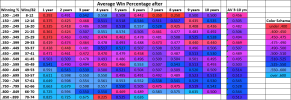I think you've all heard the idea that the worst place to be in the NBA is in the middle. It's better to be really good or really bad, it's often said. But is that true? I've had some doubts about that notion and always wanted to test it out with some real data.
So I did a (relatively) quick and dirty analysis (it still took several hours). And I think my takeaway is that the idea of NBA purgatory for NBA teams with middling records is (maybe considerably) overblown. A much bigger factor in whether the future bodes well is whether the team is good (good teams tend to stay better, on average).
By no means have I done the perfect analysis. There are several things that could make it stronger. But I think it's strong enough to justify at least some distrust of this notion of NBA purgatory. (If anyone knows of a better study on this question, please let me know.)
I basically categorized each team by winning percentages each year since the 1999-2000 season. Then I charted their average winning percentages in the subsequent 10 years, according to those same categories. If the notion of purgatory is correct, you'd expect to find (at least one or both):
Here's a summary of the winning-percentage data (if you're using the Jazzfanz app on phones, this picture may not appear):

(As you look at this data, try to ignore the percentages above .800 and below .200. There are too few cases in these categories to draw conclusions.)
Here's some of my takeaways. Let me know if you have others:
So I did a (relatively) quick and dirty analysis (it still took several hours). And I think my takeaway is that the idea of NBA purgatory for NBA teams with middling records is (maybe considerably) overblown. A much bigger factor in whether the future bodes well is whether the team is good (good teams tend to stay better, on average).
By no means have I done the perfect analysis. There are several things that could make it stronger. But I think it's strong enough to justify at least some distrust of this notion of NBA purgatory. (If anyone knows of a better study on this question, please let me know.)
I basically categorized each team by winning percentages each year since the 1999-2000 season. Then I charted their average winning percentages in the subsequent 10 years, according to those same categories. If the notion of purgatory is correct, you'd expect to find (at least one or both):
- that teams with bad records should end up with better records than the teams in the middle over time
- that teams with records in the middle would have a hard time moving up or down in the winning percentages in subsequent years
Here's a summary of the winning-percentage data (if you're using the Jazzfanz app on phones, this picture may not appear):

(As you look at this data, try to ignore the percentages above .800 and below .200. There are too few cases in these categories to draw conclusions.)
Here's some of my takeaways. Let me know if you have others:
- If you want to be good in the future, the best predictor is to be good now (especially in the near-50 wins or above categories).
- There seems to be a little bit of a bright outlook for teams that are very bad, especially 4-6 years after the bad season, but this improvement tends not to last all that long (again, this is on average, so individual team results vary).
- If there is a win total that leads to purgatory (on average), it looks to be in the 29-33 win range (the Kings' favorite range?). However, I suspect that that this win total does not really create purgatory, but rather that bad teams trying to win without effective team-building (poor drafts, poor management, poor coaching, etc.) tend to end up in this win total .
- Though I don't show it here, I ran standard deviations on these results to see whether any particular winning-percentage category is more likely to get "stuck" around a certain average in future years, not really being able to move up or down. Lower standard deviations would indicate that maybe there's something to the idea. But generally, there weren't major differences between the categories in their standard deviations. There doesn't seem to be a win-total that makes a team more likely to get stuck. If there's any (slight) pattern, it's that the standard deviations generally (though not evenly) rise as the initial winning percentage increases.
